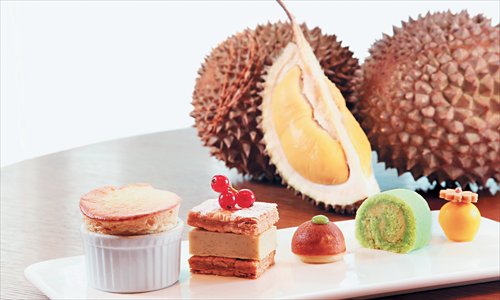Durians, a spreading smell
China warming to Malaysian ‘king of fruit’

Durians and deserts made with durians Photo: CFP
Twenty years ago, when the Malaysian businessman Loh Wee Keng came to Beijing for the first time, he carried some special "souvenirs" from his homeland: durians. However, the spiky tropical fruit seemed not so readily welcome here as in Malaysia. The pungent smell made a hotel cleaner throw up immediately after she opened Loh's room.
A novelty in the eyes of the Chinese people 20 years ago, durians can be seen everywhere nowadays in China. Although Thailand has been dominating the Chinese durian market for more than 30 years, the Chinese people are gradually warming to Malaysian durians in recent years.
Different from Thailand, Malaysia has only been given the opportunity by the Chinese government to export durians starting from 2011, when the former Chinese premier Wen Jiabao formally approved the entry of frozen Malaysian durians during his visit to Kuala Lumpur earlier in the year.
In contrast, as early as in 2010, Thailand's durian export to China hit a whopping 138,000 tons worth nearly $70 million, according to the Associated Press.
Aszmy Mahmood Yusof, agriculture counsellor of the Malaysian Embassy in Beijing, told the Global Times that, as of August last year, the export value of Malaysian frozen durians to China reached $1.2 million, adding that the export value of the whole year of 2014 was expected to surpass the figure of $1.6 million in 2013.
Loh told the Global Times that his company exported about 10 tons of durians to China in 2011, and the export volume grew to about 105 tons last year.
"Our durian exportation to China is still in a baby stage," said Loh. "But I'm sure the sales volume will grow year by year, and more Chinese people will fall for our durians."
Musang King fever
Among the Malaysian durians, the most-celebrated variety is Musang King, which also boasts a loyal legion of fans in China.
A top-quality Musang King durian generally has a brownish-grey skin with broad and blunt spikes, fruit with small seeds and pungent smell, as well as an unmistakable star-shaped mark on the bottom.
According to Loh, due to the growing popularity of Malaysian durians in China, many Chinese vendors, driven by the potential profit, flocked to Malaysia in November and December last year to purchase fresh durians in large volumes, and the sudden increase of demand sent the price of the fresh Musang King durians at local orchards to a record high level, increasing nearly tenfold to 80 yuan ($12.77) per kilogram.
Frozen Musang King durian pulp is now available in some supermarkets in China. A Beijing-based supermarket bought 2,000 packets of frozen Musang King durian products in December last year, the Xinhua News Agency reported.
The price of frozen Musang King durian pulp is about 500 yuan ($16.11) per kilogram.
Besides frozen Musang King durian pulp, people can also savor various types of desserts made of durians in many dessert shops in China, such as durian ice cream, durian cheese cakes, durian pizzas and sweet sticky rice with durians.
Fresh? Not yet
While Thai durians can be harvested shortly before they are ripe, the species of Malaysian durians generally require farmers to wait until the durians ripen on the tree before harvesting them.
Due to their short lifetime of freshness, only frozen Malaysian durians are available in most Chinese cities so far.
Besides that difference, some durian enthusiasts insist that the Malaysian durians are more fragrant and deliciously creamier than the Thai varieties.
However, despite the growing popularity of Malaysian durians, the Malaysian agriculture counsellor said that Malaysia was not ready to export fresh durians yet.
"If we export fresh durians, our concern is that we'll not be able to meet the demands," he said, adding that it was easier to control the quality of frozen durians and "make sure that only the good durians are exported to China."
"For the last year, the brand of Malaysia was associating to something not good," he said, referring to the twin disasters that hit the Malaysian airlines last year. With good-quality durians, he said Malaysia was hoping to create "a good brand, a good image, that associates with Malaysia."
Durian tour
To taste fresh durians, a tour to Malaysia obviously would be the best choice.
Every year, many durian enthusiasts are attracted to Pahang and Penang, two states located in Peninsular Malaysia, by the good-quality durians in local orchards.
The best time for a durian tour is from June to August and from November to January, when the durian output peaks.
"If you want to pick your own durians, the hotels in the local durian orchards are highly recommended," said Loh, adding that the hotels featured simple furniture and basic sanitary conditions, and charged about 200 yuan for each night.
Tourists can also go to the all-you-can-eat durian buffet stalls on the side of the street, where they can feast on various types of Malaysian durians.
Tips with durian
A durian is rich in potassium, iron, as well as vitamins B, C and E, but it can also turn into a diet killer because it is also high in calories and carbohydrates.
A durian of an average size of one kilogram has nearly 1,350 calories, reports say.
Due to the high sugar content in durians, people with diabetes should consume the fruit with even more moderation.
Researchers say there is no scientific evidence so far to prove that eating durians along with alcohol have lethal effects.
People who have not tasted durians could start off by savoring some durian-flavored cakes and cookies first, before moving up to durian desserts and finally having their first durian encounter.
The heatiness caused by durians can be reduced by eating some cooling fruits, such as mangosteens.
One can dilute the breath of durians by drinking some ginger tea. Due to its pungent smell, the durian is banned from many public places in Southeast Asian countries.